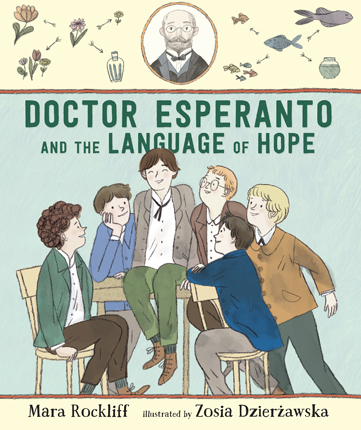| Doctor Esperanto and the language of hope Author: Rockliff, Mara | ||
| Price: $6.50 | ||
Summary:
Anger and distrust in a town, where multiple languages are spoken, lead a boy to come up with a new language that all of them can learn easily in order to better communicate with each other.
| Illustrator: | Dzierawska, Zosia |
| Accelerated Reader Information: Interest Level: LG Reading Level: 3.80 Points: .5 Quiz: 516675 |
Reviews:
Kirkus Reviews (-) (01/15/19)
School Library Journal (03/01/19)
Booklist (02/01/19)
Full Text Reviews:
Booklist - 02/01/2019 Growing up in Bialystok, Poland, in the 1860s, Leyzer Zamenhof heard many languages but not much harmony. He wondered whether, if the townspeople could understand each other through a common language, they would live in peace. In this picture-book biography, Rockliff relates Leyzer’s endeavor to create a universal language. Instead of starting from scratch, the linguist borrowed familiar cognates. And despite discouragement from his father, he found a partner in a young woman named Clara. With her help, he introduced his language in a book that he signed as Doctor Esperanto or “one who hopes.” Eventually letters arrived from like-minded individuals around the world, who called the language Esperanto because it also gave them hope. This delightful story deserves its charming illustrations, rendered in pen and ink and assembled digitally. They spread more cheer as Leyzer travels to France to attend a universal congress of Esperanto and share his language in person. Appended back matter relates more facts about Zamenhof and Esperanto’s simple structure. This inspiring, overlooked historical figure showed that experimentation isn’t limited to science. - Copyright 2019 Booklist.
School Library Journal - 03/01/2019 Gr 2–4—Dr. Esperanto, the pseudonym of L. L. Zamenhof, comes out of deep obscurity in this intriguing picture book biography. Growing up in Poland, Zamenhof spoke several languages. While he graduated from medical school and practiced as an opthamologist, his passion was creating a universal language so everyone could understand one another and live in harmony. The story deftly explains Zamenhof's attempts to create Esperanto. It also delves into his father's lack of encouragement. The story ends on a positive note, with Zamenhof joining a hopeful international conference on Esperanto in Paris. A page explaining why the language might be beneficial is appended. Further biographical information is also included. This is a true picture book, with no index. The text is fairly brief. Softly colored cartoon illustrations show various, mostly European cultures. The overall feeling is warm and optimistic. This is an inspiring story of determination and hope. VERDICT Recommended in part because there are no other books about Esperanto or Zamenhof for this grade range. Especially useful for adults interested in the language who want to share their enthusiasm with their students or children in their lives.—Anne Chapman Callaghan, Racine Public Library, WI - Copyright 2019 Publishers Weekly, Library Journal and/or School Library Journal used with permission.



